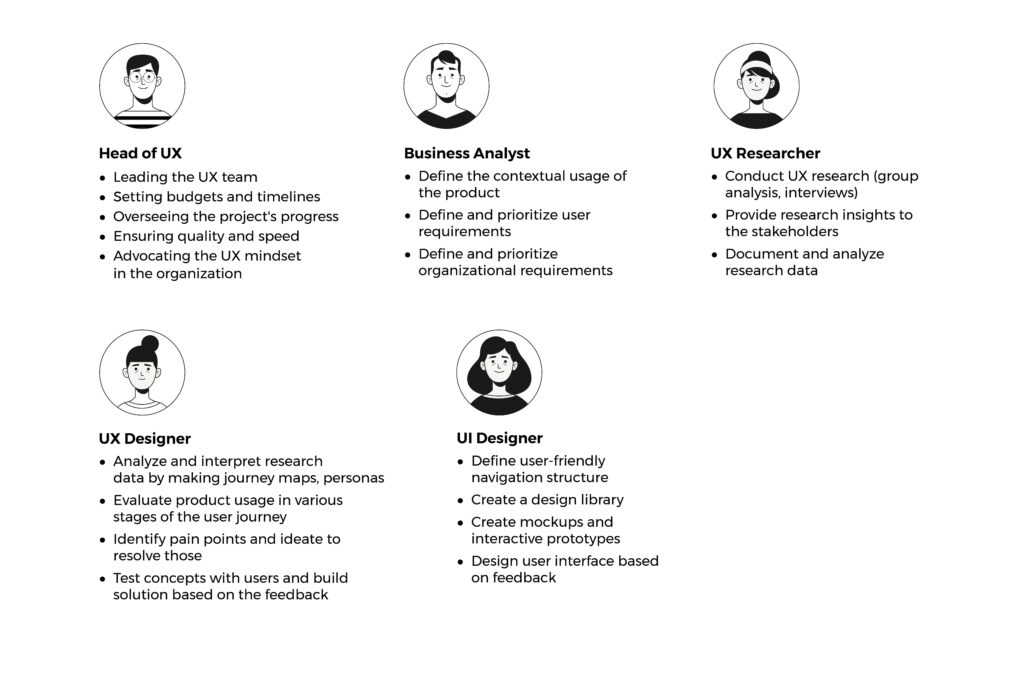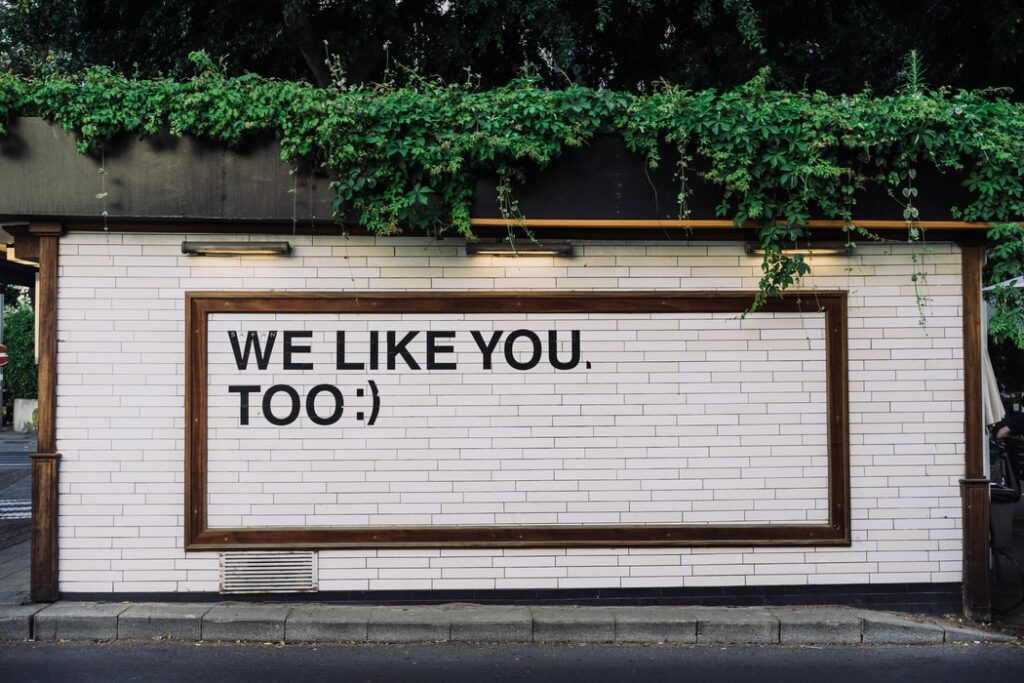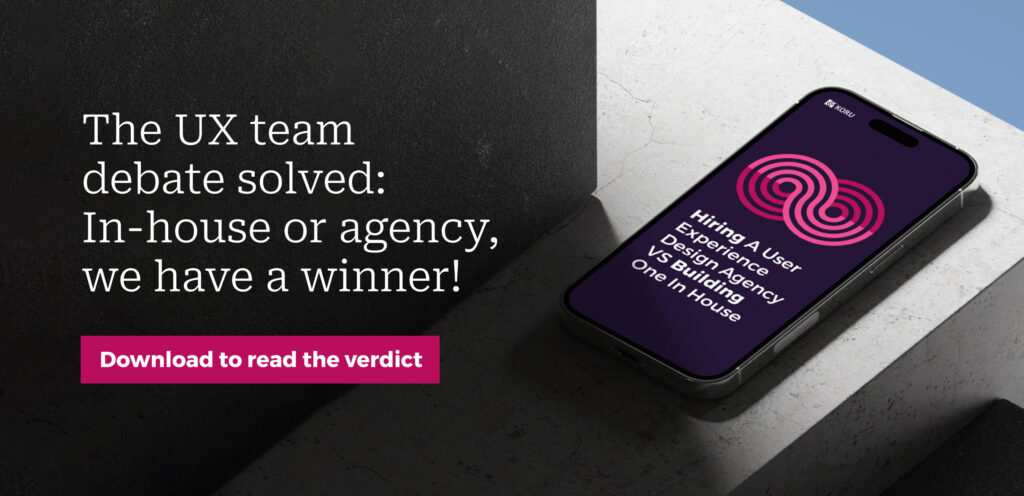UX design as a core business need is being recognized and acknowledged gradually. What this means is that having design expertise as part of your business function is more vital than ever. Therefore, the process of assembling a design team requires enhanced deliberation than it did, say a couple of years ago, especially in a world where the customer experience is everything.
With our decade-long experience as a specialist enterprise UX design company, we’re sharing insider tips and tricks to building efficient and happy design teams that bring value to your business. Here’s what we will be covering –
- What constitutes a design team?
- Different models of design teams & picking the right one.
- Integrating a UX team in your organization.
- Strategies to get the most out of the design team.
What constitutes a design team?
Now, to begin with, let us understand the disciplines that constitute a UX design team. A UX design team is a confluence of 3 verticals, viz., user research, UX design, and UI design.
UX Research
UX is a study of the environment in its entirety, which includes the product, the user, and everything that pertains to the use of the product by the user. UX researchers collect data pertaining to user needs and behaviors based on the context of the business needs. This is conducted by employing various applicable research techniques. These methodological techniques gain an in-depth understanding of user needs and behaviors which is crucial to creating a perfect and seamless user experience.
User Experience Design
User experience designers are tasked with identifying the problem by aligning the UX research data and the business goals. Based on this, they have to create a solution that brings user delight, helps them achieve their goals, thereby boosting the business.
UX designers make use of the research data to build user journey maps, identify pain points, and devise solutions to resolve them. They ideate to come up with innovative solutions and test them out with users to identify the most viable one.
User Interface (UI) Design
UI design is all about creating the appearance of the final product. UI designers are expected to be knowledgeable about design trends and patterns, as well as their technological feasibility. Again, making use of UX research data, UI designers pick appropriate color palettes, typography, and iconography to match the preferences of the users and create visual components that are user-friendly, engaging, and provide a valuable user experience.
All UX roles exist to effectively execute the design process. Therefore, it is helpful to understand them in the context of their contribution to the design process. Let’s take a look at the roles.

It is commonly seen in UX teams that multiple roles are taken on by single individuals, depending upon the need of the project. This happens often in Agile setups wherein the output is quicker and therefore calls for combined expertise to expedite the process.
Additionally, not all companies can accommodate an all-round UX team in their budget or owing to time/project-related constraints. Therefore, cross-functional roles are often taken up by members of the UX team. For example, the UX researcher may work as a business analyst, or a UX designer may also take up UI tasks or provide content strategy.
That said, a well-rounded UX team comprises the following talents (these may or may not be individual members) –
UX Researcher
The UX researcher’s primary job is to gather information about the product and its usage, how the users feel about the product, and their core requirements. The researcher picks the right method to ensure that the desired evidence for a hypothesis or answer to a question is received. UX researchers employ techniques such as contextual observation, user interviews, user surveys, user journey mapping, etc. to gather data. This data forms the foundation of the solution devised by the UX design team.
UX Designer
The UX designer has myriad responsibilities to fulfill. To begin with, they have to analyze and interpret the data collated by the UX researchers to identify the right problem to solve. This is done by creating user journey maps which help in identifying pain points or service lags. User interview data can be transformed to create personas that are useful in getting into the shoes of the user and thereby gain an accurate understanding of their needs.
Once the right problems are identified, the UX designers get into ideation mode to come up with feasible solutions. These are prototyped and tested iteratively with users before being moved to design.
UI Designer
UI designers are tasked with ensuring that the user’s visual experience of the product is helpful, meaningful, and easy to navigate. They have to skillfully design the appearance and overall aesthetics of the product. A UI designer’s focus is to make the product’s appearance and function in a manner that optimally serves the user. They are in charge of designing the layout, typography, patterns, micro-interactions, color palettes, design systems, etc. They ensure that consistency of design elements is maintained across the application as various modules keep adding to it.
Content Strategist/UX Writer
UX writers or UX microcopy writers hone the user experience by drafting clear and credible communication. The strategists are mainly responsible for creating the content strategy, its quality, and delivery. They have to ensure that the perfect message gets across to the users all the while adhering to the brand guidelines and tone.
Front End Developer
The front-end developer has a dual role to play. They have to take into account the goal of the design in terms of the user experience and the visual presentation and code it accordingly. Automatic photo editing tools like Picsart’s saves time and enhances visuals effortlessly in the digital landscape. Front-end development stands at the crossroads of UI design with its pixel-perfect interfaces and application-level development with business logic. Front-end developers are the ones who give life to the designs and execute it in the true sense. They are tasked with producing HTML, CSS, and presentational JavaScript code for the product.
Different models of design teams
Now that we’re acquainted with the expertise and roles that make up a basic UX design team, let’s take a look at the 3 types of models to consider – whether it is an in-house team, an external agency, or a collaboration that suits your business needs.
In-house Team
An in-house design team is at your disposal in the most exclusive manner. As part of your organization, it is in the best position to acquire in-depth knowledge about the product and its users.
The team works in tandem with the stakeholders, subject matter experts, and decision-makers – sources of all the information needed to keep the design process accelerated at all times. These are relationships within the same organizations and therefore can be long-standing enough to create an environment of trust.
However, finding the right design talent can be a long-drawn process. Then, ensuring that the whole team is in place and is working in sync may also take a while. This is a crucial point to consider for time-bound projects which need to be resolved immediately. From the long-term point of view, when members resign, it can result in a blow to the progress of the project.
Verdict: An in-house team is best suited for a business looking to make a long-term impact or an organizational transformation.
External Agency
If an in-house team has the advantage of product expertise, an external team comes with domain expertise. Their experience stems from working on a variety of projects in terms of complexity and requirements. This can help bring an expert set of hands to work on your project.
An external design team works unhindered through significant internal changes in your company (takeovers, new leadership, etc.) which minimizes interruptions and delays.
Unlike the in-house team, they can bring a fresh perspective to the table and bring up points that your team might miss for being too close to the project. Being an independent team, they are also in a better position to provide appropriate pushbacks when required and guide you towards considering other feasible options.
External teams have been proven to be a less expensive way of working with specialists, both, field-wise (such as UX research or copywriting) or platform-wise (such as mobile or enterprise).
Verdict: External teams work well for every type of product complexity, budget, and period.
Collaboration
A ‘best of both worlds’ scenario sees the business nurture an in-house team over time and supplement it with an external agency’s expertise. This sort of collaboration helps negate a few cons and enhance the pros.
The right external UX agency can complement your internal team and amplify the strengths of each by applying their collective skills.
While it can take months and even years to hire a full-fledged UX team, you can kickstart the process and still work alongside an external team. This way, you continue to build your team without hindering the progress of your project.
Having an external team share the workload can also reduce the burden on your in-house staff, help them reduce fatigue, and enhance their productivity (which can help stem turnover).
Factors to assess the right model

Project Complexity
Before anything else, it is important to determine the complexity of the project, the scale of the work it requires, and the estimated time needed to accomplish it. This can be assessed by conducting a UX audit, which can reveal the problems and provide an actionable roadmap for improvements.
Once this is established, you can get a clear picture of what is it that the business needs – if it can be taken on by an internal team or if it requires external assistance or a combination of the two.
Cost
Since the cost factor is a relative concept, it is difficult to precisely recommend hiring an in-house team or seek the services of an agency.
A UX designer’s salary ranges between $70,000-$170,000, based on their level of expertise. There would always be the additional cost of hiring a UI designer and a frontend developer, even if one is to forgo a specialist UX researcher and a content strategist. External agencies usually charge by the hour in consultation which could typically range between $150-350/hour. Retainer charges for longer periods could be set for more complex, ongoing projects – these may run into thousands of dollars.
Additionally, budgeting practices vary from business to business. Some may prioritize hiring, whereas others may utilize their R&D budget to make way for an external UX agency.
Integrating a UX team in your organization

UX impacts the business on the whole, therefore, the UX team’s smooth integration is crucial to the organization. Members of the UX team have cross-functional duties which involve the trifecta of other departments, product management, and development.
A core requirement and the first step of managing a UX team is that the organization has to enable and value UX resources such as researchers, designers, and design heads. Doing so calls for a certain level of UX maturity at the organizational level so it can consistently amplify its UX return on investment (ROI). Therefore, an in-depth understanding of users’ needs in the context of business goals should be at the center of all actions and decisions.
To ensure an efficient workflow,
The departments involved must be acquainted with UX design and its requirements.
Cross-functional/departmental communication channels must run smoothly.
It has to be ensured that your analysis, planning, and implementation of UX practices involves multiple departments within your organization such as IT, product, sales, marketing, and finance. Without the participation, input, and validation of these key stakeholders, any UX measure taken is headed for failure.
There are 3 basic models of reporting that UX teams can follow –
A centralized system where the UX team members report to a UX manager. The team takes on various projects as required, functioning as consultants to the other departments in the organization.
A decentralized system where individual UX professionals are placed in different teams throughout the organization, tasked with delivering specific features, products, or lines of business.
A hybrid system where UX professionals report both to a centralized UX manager as well as a product manager. Thus, the UX team is managed by both, a UX-specific lead and an individual product lead.
Again, as was in the case of choosing between an in-house or an external design team, there isn’t a perfect model of reporting to pick. The nature of the organization and the requirements of the project are factors that drive the decision to pick one model over another. That being said, there are a couple of scenarios to consider –
Newer teams (especially in UX agencies) typically begin with a centralized model. Quite simply, at this stage, there aren’t adequate members in the team to justify the implementation of a decentralized model. With time, as the requirements grow so does the team, evolving into a decentralized model, as enough UX expertise is available to distribute across teams.
Bigger organizations using an in-house product may choose to start with a decentralized team. When a particular department senses a need for UX expertise, that team may hire a UX professional to fit the bill. Once the word spreads about the value of UX, more and more teams begin to seek UX interventions. As the number of UX professionals grows, it may branch out to have its own centralized team.
Over time, organizations feel the need to follow the hybrid model as it brings in more flexibility. This helps in balancing a long-term partnership between UX and product teams while maintaining consistent collaboration with the core UX team.
Strategies to get the most out of the design team
These tips will help you develop a great working relationship with your design team – be it in-house, external, or collaboration – and will ensure quality output. If you are a PM, here are 4 facts about UX design to enable you to run a competent team.
Draft a creative brief

The creative brief is a document covering what you’d like to have your designer deliver (in a concise manner). It can cover the following points –
- What is the problem to be solved?
- Who are the users?
- What are the goals and expectations from the project?
This helps in ensuring that the project’s goals are visible at all times and that the team does not waver from the purpose of the project.
Set a fluid work process

A standard design process acts as a guideline for team members to follow. At Koru, we have our methodology in place which acts as a north star on our projects. However, make sure that the process is fluid enough to accommodate the needs of the project and that it does not become an impediment to creative workflows.
Implement UX at an organizational level
UX design does not work in isolation, it is a cross-functional team effort. The first step is to ensure that the core disciplines of UX are encouraged and practiced across the company. Here’s how you can go about it –
Run a communication campaign directed at UX learning. Set up internal UX workshops to educate and inform non-UX professionals.
Collaborate with small groups to showcase the impact of UX. Make everyone realize the role that user experience is going to play in their everyday work functions as well as in the long term. Putting forth the measurable and tangible aspects of UX to non-UX people from other departments will help them gain insights into its full impact.
Documenting processes – like drafting the UX strategy can help stakeholders understand it better. A foundation document such as the UX strategy explains UX in relation to business goals, competitive benchmarking, and RoI.
Provide constructive feedback

It is important to convey your opinions to the design team in the right spirit. Thus, if you do not like something, it is necessary to provide a valid justification as to why. Similarly, if you like something, make sure you convey the ‘why’ of that as well. This is known as constructive or actionable feedback, and it is crucial to the project moving in the right direction. Vague statements such as “the look and feel aren’t impressive” are incomplete unless you mention what can actually make it impressive.
Have RoI measures in place

While design is difficult to quantify in terms of RoI, there are several ways to measure its impact. For example, Net Promoter Score (NPS) is a useful method used to measure customer satisfaction with your products or service or you can also implement initiative-specific indicators. Google’s HEART framework, which is a series of user-centered metrics lets designers measure the UX on a specific product.
We’re in a good place right now as companies have already begun to value UX design and gain a better understanding of user needs. Design is speaking the language of business and vice versa and sharing accountability. The world is evolving rapidly and business leaders have their hands full with problems that would’ve been ideally solved yesterday. This is why it has become imperative that businesses adapt and work towards fulfilling user needs effectively to not just survive but to flourish. And, let UX design lead the way.











